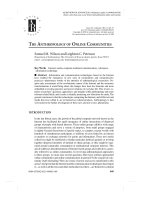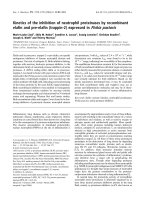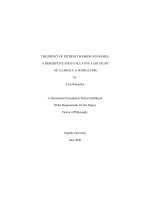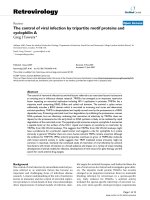The economics of sports 5th by michael a leed and allmen chapter 02
Bạn đang xem bản rút gọn của tài liệu. Xem và tải ngay bản đầy đủ của tài liệu tại đây (2.91 MB, 41 trang )
The Economics of Sports
FIFTH EDITION
Chapter 2
Review of the
Economist’s
Arsenal
MICHAEL A. LEEDS | PETER VON ALLMEN
Learning Objectives
• Use basic supply and demand model to
explain the price of trading cards
• Describe how teams allocate the players’
talents to generate wins
• Distinguish monopoly from perfect
competition and apply it to ticket pricing
• Explain the origins of the professional sports
Copyright ©2014 Pearson Education, Inc. All rights reserved.
2-2
2.1 Supply and Demand
• This is the first model we use
• Models are simplified versions of reality that
isolate the most important factors
• We will use this model throughout the book
• The following slides offer a review
Copyright ©2014 Pearson Education, Inc. All rights reserved.
2-3
Law of Demand
• Price and quantity demanded of a good are
inversely related, ceteris paribus
• As own price rises, consumers switch to
other products to make them happy
– They purchase more of other goods that are
cheaper and less of the good whose price has
fallen, for example baseball cards
– They can afford more cards as well
Copyright ©2014 Pearson Education, Inc. All rights reserved.
2-4
Law of Supply
• Price and quantity supplied of a good are
positively related, ceteris paribus
• As reward rises, so does the activity
• Example: the supply of baseball cards
• See Figure 2.2
Copyright ©2014 Pearson Education, Inc. All rights reserved.
2-5
Figure 2.2
Copyright ©2014 Pearson Education, Inc. All rights reserved.
2-6
Equilibrium
• The equilibrium in the market occurs at the
intersection of supply and demand (Figure
2.3)
• If the price in the market is above the
equilibrium, there is excess supply or a
surplus
• If the price is below equilibrium, there is
excess demand or a shortage
Copyright ©2014 Pearson Education, Inc. All rights reserved.
2-7
Figure 2.3
Copyright ©2014 Pearson Education, Inc. All rights reserved.
2-8
Factors that Shift Demand
• Consumer income (usually positively
related)
• Prices of other related goods
– Substitutes (+) or complements (-)
• Consumer tastes
• Number of consumers in the market (+)
• Expectations of consumers
Copyright ©2014 Pearson Education, Inc. All rights reserved.
2-9
Factors that Shift Supply
•
•
•
•
•
Prices of inputs (-)
Technology (+)
Taxes (-)
Natural and man-made disasters (-)
Expectations of suppliers
Copyright ©2014 Pearson Education, Inc. All rights reserved.
2-10
Figure 2.4
Copyright ©2014 Pearson Education, Inc. All rights reserved.
2-11
Application
• Why is a Mickey Mantle card more expensive
than a Hank Aaron card?
• We assume that the supply of both cards is
the same
• The demand for Mickey Mantle cards is
higher because of the effect of three
variables: income, the number of
consumers, and tastes
Copyright ©2014 Pearson Education, Inc. All rights reserved.
2-12
Effect of Three Variables
–
Larger number of consumers for
Mantle
– We assume that people prefer the players in their
home towns teams
– Mantle spent his career in larger NY and Aaron in
smaller Milwaukee & Atlanta
• NY consumers have higher incomes
• “Taste:” Discriminatory consumers might
prefer Mantle, who was white
Copyright ©2014 Pearson Education, Inc. All rights reserved.
2-13
2.2 Producing Output and
the Production Function
• Production functions show how much output
a firm generates from its inputs
• What is output in sports?
– Games played?
– Wins generated?
• Either is possible, depending on context
Copyright ©2014 Pearson Education, Inc. All rights reserved.
2-14
Figure 2.5
Copyright ©2014 Pearson Education, Inc. All rights reserved.
2-15
Figure 2.6
Copyright ©2014 Pearson Education, Inc. All rights reserved.
2-16
Figure 2.7
Copyright ©2014 Pearson Education, Inc. All rights reserved.
2-17
Figure 2.8
Copyright ©2014 Pearson Education, Inc. All rights reserved.
2-18
Figure 2.9
Copyright ©2014 Pearson Education, Inc. All rights reserved.
2-19
An Example:
The Production of Wins
• Q = f(TO, TD)
– Wins are a function of offensive talent (TO) and
defensive talent (TD)
• Wins rise as each talent rises
– Marginal Product of Offensive (Defensive) talent
is the contribution of a one-unit increase in
offensive (defensive) talent to wins (MPTo =
Q/TO)
– MPT rises then falls (Figures 2.10a – 2.10b)
– What does Tom Brady add when the team already
has Eli Manning?
Copyright ©2014 Pearson Education, Inc. All rights reserved.
2-20
Marginal Cost
• MC is the cost of producing one more unit of
output
– The cost of one more win (or game)
– MC = ΔC /ΔQ
• MC is inversely related to MP
– More productive inputs add to output more
cheaply
– See Figures 2.10b and 2.10c
Copyright ©2014 Pearson Education, Inc. All rights reserved.
2-21
Figures 2.10b and 2.10c
Copyright ©2014 Pearson Education, Inc. All rights reserved.
2-22
Price Ceilings
• An official upper limit on price
• Ceilings must be set below Pe to have any
effect
• Price ceilings create
– Excess Demand (Figure 2.11)
– Black markets – ticket scalping
• Openly violate the law
– Gray markets – selling tickets and pencils
• Violate the spirit but not the letter of the law
Copyright ©2014 Pearson Education, Inc. All rights reserved.
2-23
2.3 Market Structures
• In perfect competition, each producer is
too small to affect prices
• The competitor takes market price as given;
it represents his marginal revenue (P=MR)
(Figure 2.12)
• The perfect competitor, as any other
producer, maximizes profit at output where
MR=MC (Figure 2.13)
Copyright ©2014 Pearson Education, Inc. All rights reserved.
2-24
Figure 2.11
Copyright ©2014 Pearson Education, Inc. All rights reserved.
2-25









